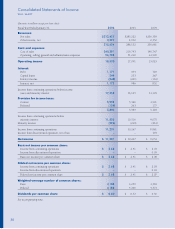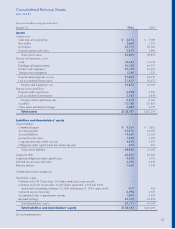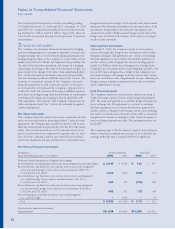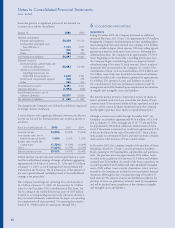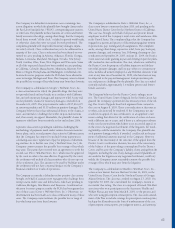Walmart 2006 Annual Report Download - page 36
Download and view the complete annual report
Please find page 36 of the 2006 Walmart annual report below. You can navigate through the pages in the report by either clicking on the pages listed below, or by using the keyword search tool below to find specific information within the annual report.
Notes to Consolidated Financial Statements
WAL-MART
34
1 SUMMARY OF SIGNIFICANT ACCOUNTING POLICIES
Consolidation
The consolidated fi nancial statements include the accounts of
Wal-Mart Stores, Inc. and its subsidiaries (“Wal-Mart” or the
“Company”). Signifi cant intercompany transactions have been
eliminated in consolidation. Investments in which the Company
has a 20 percent to 50 percent voting interest and where the
Company exercises signifi cant infl uence over the investee are
accounted for using the equity method.
The Company’s operations in Argentina, Brazil, China, Germany,
Japan, Mexico, South Korea and the United Kingdom are con-
solidated using a December 31 fi scal year-end, generally due to
statutory reporting requirements. There were no signifi cant inter-
vening events which materially affected the fi nancial statements.
The Company’s operations in Canada and Puerto Rico are consoli-
dated using a January 31 fi scal year-end.
The Company consolidates the accounts of certain variable inter-
est entities where it has been determined that Wal-Mart is the
primary benefi ciary of those entities’ operations. The assets, liabil-
ities and results of operations of these entities are not material to
the Company.
Cash and Cash Equivalents
The Company considers investments with a maturity of three
months or less when purchased to be cash equivalents. The major-
ity of payments due from banks for third-party credit card, debit
card and electronic benefi t transactions (“EBT”) process within 24-
48 hours, except for transactions occurring on a Friday, which are
generally processed the following Monday. All credit card, debit
card and EBT transactions that process in less than seven days are
classifi ed as cash and cash equivalents. Amounts due from banks
for these transactions classifi ed as cash totaled $575 million and
$549 million at January 31, 2006 and 2005, respectively.
Receivables
Accounts receivable consist primarily of receivables from insurance
companies resulting from our pharmacy sales, receivables from
suppliers for marketing or incentive programs, receivables from
real estate transactions and receivables from property insurance
claims. Additionally, amounts due from banks for customer credit
card, debit card and EBT transactions that take in excess of seven
days to process are classifi ed as accounts receivable.
Inventories
The Company values inventories at the lower of cost or market as
determined primarily by the retail method of accounting, using
the last-in, fi rst-out (“LIFO”) method for substantially all mer-
chandise inventories in the United States, except SAM’S CLUB
merchandise and merchandise in our distribution warehouses,
which is based on the cost LIFO method. Inventories of foreign
operations are primarily valued by the retail method of account-
ing, using the fi rst-in, fi rst-out (“FIFO”) method. At January 31,
2006 and 2005, our inventories valued at LIFO approximate
those inventories as if they were valued at FIFO.
Financial Instruments
The Company uses derivative fi nancial instruments for purposes
other than trading to manage its exposure to interest and for-
eign exchange rates, as well as to maintain an appropriate mix of
fi xed and fl oating-rate debt. Contract terms of a hedge instrument
closely mirror those of the hedged item, providing a high degree
of risk reduction and correlation. Contracts that are effective at
meeting the risk reduction and correlation criteria are recorded
using hedge accounting. If a derivative instrument is a hedge,
depending on the nature of the hedge, changes in the fair value of
the instrument will either be offset against the change in fair value
of the hedged assets, liabilities or fi rm commitments through
earnings or recognized in other comprehensive income until the
hedged item is recognized in earnings. The ineffective portion of
an instrument’s change in fair value will be immediately recog-
nized in earnings. Instruments that do not meet the criteria for
hedge accounting, or contracts for which the Company has not
elected hedge accounting, are marked to fair value with unrealized
gains or losses reported in earnings during the period of change.
Capitalized Interest
Interest costs capitalized on construction projects were $157 mil-
lion, $120 million, and $144 million in fi scal 2006, 2005 and
2004, respectively.
Long-Lived Assets
Long-lived assets are stated at cost. Management reviews long-
lived assets for indicators of impairment whenever events or
changes in circumstances indicate that the carrying value may not
be recoverable. The evaluation is performed at the lowest level of
identifi able cash fl ows, which is typically at the individual store
level. Cash fl ows expected to be generated by the related assets
are estimated over the asset’s useful life based on updated projec-
tions. If the evaluation indicates that the carrying amount of the
asset may not be recoverable, any potential impairment is mea-
sured based on a projected discounted cash fl ow method using a
discount rate that is considered to be commensurate with the risk
inherent in the Company’s current business model.
Goodwill and Other Acquired Intangible Assets
Goodwill is not amortized; rather it is evaluated for impairment
annually or whenever events or changes in circumstances indi-
cate that the value of certain goodwill may be impaired. Other
acquired intangible assets are amortized on a straight-line basis
over the periods that expected economic benefi ts will be provided.
These evaluations are based on discounted cash fl ows and incor-
porate the impact of existing Company businesses. The analyses
require signifi cant management judgment to evaluate the capacity
of an acquired business to perform within projections. Historically,
the Company has generated suffi cient returns to recover the cost
of the goodwill and other intangible assets.
Notes to Consolidated Financial Statements
WAL-MART








